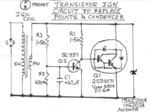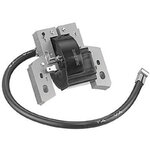Externet
Advanced Member level 2
- Joined
- Jan 29, 2004
- Messages
- 579
- Helped
- 28
- Reputation
- 58
- Reaction score
- 29
- Trophy points
- 1,308
- Location
- Mideast US
- Activity points
- 5,657
Hi. Small engines like lawn mowers get their spark from magnetos, from a passing magnet at the flywheel.
Is the primary winding acting raising the voltage while the magnet approaches, reaching a peak value and then decreasing, sort of a sine peak ? The spark occurring when the magnetic field is decreasing from its maximum ?
If the primary waveform from the induction, instead of decreasing sinusoidally is abruptly shut off at peak; would the high voltage generated for the spark be considerably higher ?
Am asking as found a gadget/circuit intended to do that; if I understand what it is doing -attached image borrowed from the web-
At left, the magneto secondary and primary windings. How does the shorting of primary winding detects the peak to collapse the magnetic field, or, am I understanding it wrong ? How does it work ?
Is the primary winding acting raising the voltage while the magnet approaches, reaching a peak value and then decreasing, sort of a sine peak ? The spark occurring when the magnetic field is decreasing from its maximum ?
If the primary waveform from the induction, instead of decreasing sinusoidally is abruptly shut off at peak; would the high voltage generated for the spark be considerably higher ?
Am asking as found a gadget/circuit intended to do that; if I understand what it is doing -attached image borrowed from the web-
At left, the magneto secondary and primary windings. How does the shorting of primary winding detects the peak to collapse the magnetic field, or, am I understanding it wrong ? How does it work ?

